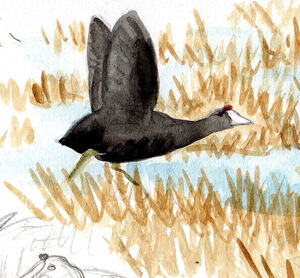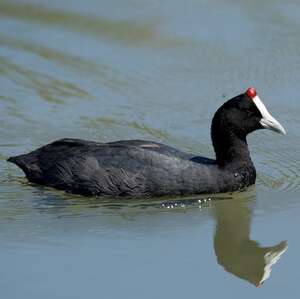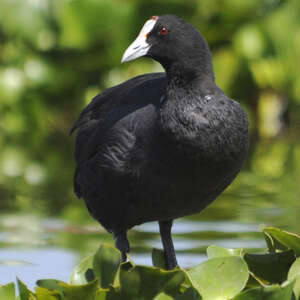Red-knobbed Coot
Fulica cristata - Foulque caronculée Foulque à crête
Identification
The Red-knobbed Coot is very similar to the Common Coot, but the end of the secondary flight feathers is lacking in white (visible when in flight). Its dark plumage is more uniform. The two sexes are similar. On side view, the back is relatively flat and the rear slightly raised. During the nesting period two variable-sized, dark red protuberances above the frontal plate allow it to be identified if the viewing distance is not too great and if good lightening is provided. The beak and frontal plate are white with a bluish hue. The frontal plate is more rectangular unlike the Common Coot's which is more rounded. The iris is red. The legs and toes are slate blue, with the tibiae having a yellowish band. The head is angular and the neck appears slim in flight compared to the Common Coot.
Juveniles have no protuberances. They are white grey on the sides of the head, front neck and chest. The chick is covered with black down except on the head which is coloured a reddish orange. The beak is red with a black tip.
Subspecific information monotypic species
Foreign names
- Foulque caronculée,
- Focha moruna,
- galeirão-de-crista,
- Kammblässhuhn,
- bütykös szárcsa,
- Knobbelmeerkoet,
- Folaga crestata,
- kamsothöna,
- Knoppsothøne,
- lyska hrebenatá,
- lyska hřebenatá,
- Kamblishøne,
- kruununokikana,
- Bleshoender,
- fotja banyuda,
- Hnúðhæna,
- łyska czubata,
- paugurknābja laucis, Āfrikas laucis,
- grebenasta liska,
- Хохлатая лысуха,
- アフリカオオバン,
- 红瘤白骨顶,
- kamsothöna,
- 鳳頭瓣蹼雞,
Voice song and call
Habitat
Behaviour character trait
She is a bit shier than the Common Coot. At the slightest alert she seeks refuge in the vegetation. During the breeding season she is very territorial and chases away all intruders who enter her domain.
In the winter she becomes gregarious and gatherings of over a thousand individuals can be seen.The Red-knobbed Coot spends most of its time swimming in search of food. To feed it can dive or remain at the surface. It can also graze on land. It spends long moments grooming itself at the fringes of reed beds. It only takes flight in cases of absolute necessity and prefers to run on water to flee danger or get rid of an intruder.
Dietfeeding habits
Reproduction nesting
The two adults take part in the construction of the nest. This is a floating platform built with reeds and reed grass.
The cup-shaped nest is often lined with dry leaves. The female lays 5 to 7 pale fawn eggs with black or rust-coloured spots and a length of 52 mm at their longest dimension. Incubation, provided by the couple, lasts from 20 to 22 days. The fledglings leave the nest 24 hours after hatching. They will stay under the parental care for a month and complete their growth after 55 to 60 days.Geographic range
Threats - protection
IUCN conservation status
concern
in the Wild
threatened
evaluated
On a global scale, the Red-knobbed Coot has a not very concerning status and is classified as LC by the IUCN. In Morocco and even more in Spain, the species was close to extinction in the early 1980's due to hunting and the loss or degradation of its habitats. A reintroduction plan and protection measures have allowed to maintain the species in Spain.
Sources of information
- IOC World Bird List (v15.1), Gill, F and D Donsker (Eds). 2025-12-07.
- Vol. 3 - Handbook of the Birds of the World, Josep del Hoyo-Andrew Elliott-Jordi Sargatal
- Birds of Africa South of the Sahara, Ian Sinclair and Peter Ryan
- BirdLife International, BirdLife International
Other sources of interest
 Specification sheet created on
03/08/2023 by Jean-Pierre Trouillas
Specification sheet created on
03/08/2023 by Jean-Pierre TrouillasTranslation by AI Oiseaux.net
© 1996-2025 Oiseaux.net
- Accipitriformes
- Aegotheliformes
- Anseriformes
- Apodiformes
- Apterygiformes
- Bucerotiformes
- Caprimulgiformes
- Cariamiformes
- Casuariiformes
- Charadriiformes
- Ciconiiformes
- Coliiformes
- Columbiformes
- Coraciiformes
- Cuculiformes
- Eurypygiformes
- Falconiformes
- Galliformes
- Gaviiformes
- Gruiformes
- Leptosomiformes
- Mesitornithiformes
- Musophagiformes
- Nyctibiiformes
- Opisthocomiformes
- Otidiformes
- Passeriformes
- Pelecaniformes
- Phaethontiformes
- Phoenicopteriformes
- Piciformes
- Podargiformes
- Podicipediformes
- Procellariiformes
- Psittaciformes
- Pterocliformes
- Rheiformes
- Sphenisciformes
- Steatornithiformes
- Strigiformes
- Struthioniformes
- Suliformes
- Tinamiformes
- Trogoniformes

































